Engravings of the year 1630
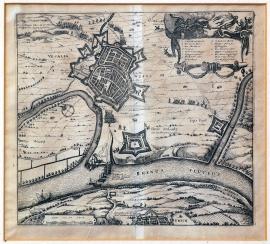
Wesel
The copperplate depicts the Rhine and two fortresses. On the peninsula, beside the shipping bridge which is just being built, stands a cargo crane whose system is remarkably effective and built in a modern way. The crane is unloading cargo from ships. A little further is the fortified town of Wesel, from which the Spanish are retreating on one side, and the Dutch are entering on the other. The cartouche with the legend A-I is a very interesting allegory: the figure representing Spain is holding a chain to which a lion is tied (i.e. the Netherlands). The lion is holding two banners with the inscriptions Herzogenbusch and Venloo. Under the chain there is the inscription “Wesel”. A hand is coming out of the clouds, holding a scissors which it is using to cut the chain. The hand is labelled with the inscription “Hand Gottes“.
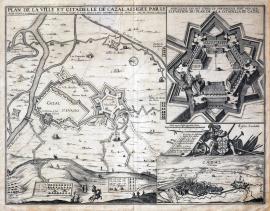
A plan of the town and fortress of Cazal, besieged by Lord Marquis of Spinola on the 24th of May 1630, and which was defended by the Lord of Toyras until the 18th of October, when it was liberated by the armies of King Louis XIII of France.
On the left-hand side of the picture, the river Po and the town and citadel of Cazal are depicted. The illustrated scene is explained with French and Dutch text. On the right-hand side there is a detailed depiction of the citadel, and lower down a measuring scale is shown. The decorative ribbon contains the town emblem and the legend 1-10. In the bottom right-hand corner there is a perspective view of the town and countryside.
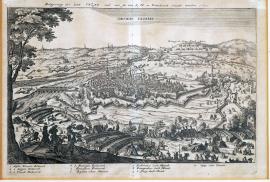
The siege of the town of Cazal, which was freed by His Royal Majesty of France in 1630.
This is a view of the Po lowlands, in the middle of which lies the town of Cazal above the river Po. In the foreground there are artillery batteries and military camps; on the left under a tree there are three officers studying a map. In the background there are military divisions and behind them there are Alpine mountain panoramas. In the sky there is the inscription “Obsidio Casalis“. Above the picture there is the quoted German text and the legend 1-10.
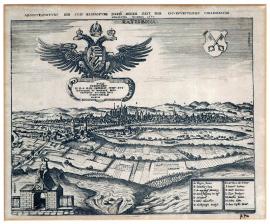
A depiction of the city of Regensburg, in which an electoral assembly was held at the time, in 1630.
The engraving, with a view of the city of Regensburg on the Danube, has been carefully drawn. In the foreground there are fields divided by borders; at the bottom on the left there is an allegorical gate with the city's coat of arms and a male figure which is looking at the city. At the bottom on the right, the legend A-O is shown in two rectangles. In the sky above the city there is a large Imperial eagle, holding in its talons a decorative board with a tribute to Emperor Ferdinand II.: “Divo Ferdinando etc.“. On the right-hand side there is the city emblem with the inscription: “Ratisbona“. The above-quoted German text is located above the picture.
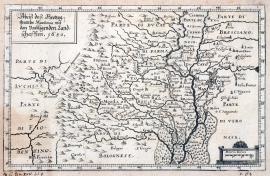
A map of the Duchy of Mantua, with the countryside which surrounds it.
On the right side of the engraving, the Po river has been drawn; on the left are the ridges of the Apennines. On the top left-hand corner there is a rectangle with the quoted text. All the edges are marked with the measuring scale “Miliaria italica“.
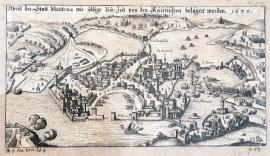
A drawing of the town of Mantua, as occupied by Imperial forces at the time. 1630
This is a very accurately executed depiction of the battle for the town of Mantua. Mantua itself is very carefully and accurately engraved; the town is surrounded by water. In the left foreground, there are three firing cannons. The quoted German text is located in the upper part of the etching.
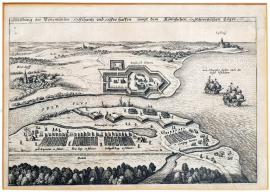
A depiction of the Peenemünd field fortification, and the royal Swedish camps.
Immediately after landing on German soil near the island of Rügen on the 4th of July 1630, Gustav Adolf of Sweden began fortifying several locations on the coast so that he could safely carry out operations further into the German hinterland. These footholds included the Peenemünd fortress, located near the outlet of the river Oder into the sea, south of the island of Rügen. The king also had a similar fixed point established near Wollgast, not far from Peenemünd. Defensive actions by Imperial forces against the landing and attacking Swedes were feeble, since the Imperial forces were thinly scattered across the whole of Pomerania and Mecklenburg.
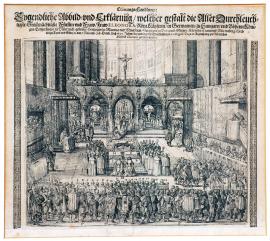
The story of the coronation: Special illustrations and explanations of the method of ceremonial coronation of the Roman Empress on the 7th of November (28th of October) 1630, on the occasion of the end of the electoral assembly in Regensburg, of Her Highness Princess Lady Eleonora, Roman Empress in Germania, Hungarian and Czech queen, Archduchess of Austria, née Duchess of Mantua, Duchess of Burgundy etc.
The picture represents the interior of the Regensburg house in which Eleonora of Mantua was crowned Roman Empress. Above the chancel there is a large cross under which, in front of the altar, kneels the Empress with three bishops, of which one is placing the crown on her head. On the left, underneath a canopy, kneels the Emperor. The whole space is filled by a large number of various dignitaries.


